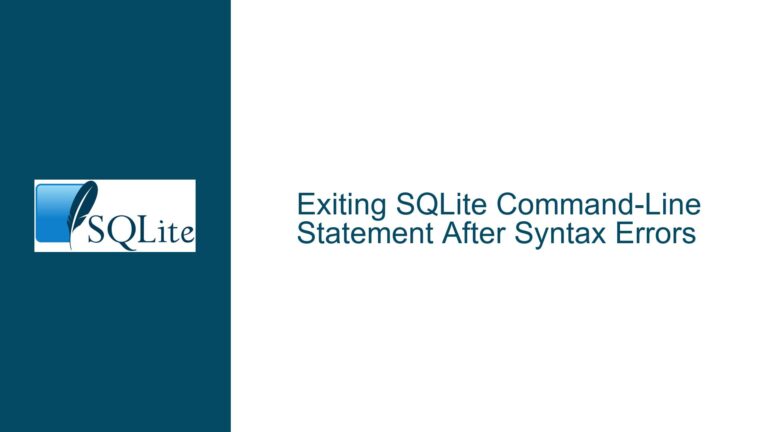Determining SQLite Prepared Statement Completion Status Without Resetting
Understanding Prepared Statement Execution State in SQLite
1. Execution Lifecycle of SQLite Prepared Statements
State Transitions and API Interactions
SQLite prepared statements (sqlite3_stmt objects) exist in three fundamental states throughout their lifecycle:
Ready State
Initial state after successful preparation viasqlite3_prepare_v2(). The statement hasn’t been executed yet. Callingsqlite3_step()from this state begins execution.Busy State
Activated whensqlite3_step()returns SQLITE_ROW (for SELECT queries) or during ongoing execution for data modification statements. The statement retains internal cursor positions and bound parameters.Done State
Final state reached whensqlite3_step()returns SQLITE_DONE. For SELECT statements, this indicates all rows have been retrieved. For write operations, it confirms command completion. The statement remains in this state until explicitly reset.
Critical API Function Behaviors
- sqlite3_step(): Advances statement execution. Returns:
- SQLITE_ROW: Row data available (SELECT)
- SQLITE_DONE: Execution completed
- Error codes for failures
- sqlite3_reset(): Returns statement to Ready State while preserving bound parameters
- sqlite3_stmt_busy(): Returns non-zero if statement is Busy State (mid-execution)
Core Challenge Definition
Developers need to answer two distinct questions about prepared statement status:
- Completion Check: Has the statement reached SQLITE_DONE since last reset?
- Execution Safety: Can we call
sqlite3_step()without first resetting?
The SQLite C Interface provides no direct API to query completion status. This leads to common misunderstandings about using sqlite3_stmt_busy() as a completion indicator.
2. Common Misconceptions and Implementation Pitfalls
Misinterpreting sqlite3_stmt_busy()
False Assumption:
"sqlite3_stmt_busy() == 0 means the statement completed successfully"
Reality:
The function only indicates whether the statement is mid-execution (Busy State). A zero return could mean either:
- Never executed (Ready State)
- Completed execution (Done State)
Example Scenario:
sqlite3_stmt* stmt;
sqlite3_prepare_v2(db, "SELECT * FROM users", -1, &stmt, 0);
// stmt: Ready State
printf("%d\n", sqlite3_stmt_busy(stmt)); // 0
sqlite3_step(stmt); // Returns SQLITE_ROW
// stmt: Busy State
printf("%d\n", sqlite3_stmt_busy(stmt)); // 1
while(sqlite3_step(stmt) == SQLITE_ROW) {} // Exhaust results
// stmt: Done State
printf("%d\n", sqlite3_stmt_busy(stmt)); // 0
Parameter Binding Edge Cases
Bound parameters persist through resets but affect execution state:
sqlite3_stmt* stmt;
sqlite3_prepare_v2(db, "INSERT INTO logs(msg) VALUES(?)", -1, &stmt, 0);
sqlite3_bind_text(stmt, 1, "test", -1, SQLITE_STATIC);
sqlite3_step(stmt); // SQLITE_DONE
// stmt: Done State
sqlite3_reset(stmt);
// stmt: Ready State with parameter still bound
Multi-Connection Statement Handling
Statements are tied to specific database connections. Attempting to check status across connections creates undefined behavior:
sqlite3* db1, db2;
sqlite3_open(":memory:", &db1);
sqlite3_open(":memory:", &db2);
sqlite3_stmt* stmt;
sqlite3_prepare_v2(db1, "SELECT 1", -1, &stmt, 0);
// WRONG: Using statement with different connection
printf("%d\n", sqlite3_stmt_busy(db2, stmt)); // Undefined behavior
3. Robust Solutions for Completion Checking and Safe Execution
Solution 1: State Tracking Wrapper
Implementation Strategy:
Create a struct wrapping sqlite3_stmt with execution state tracking:
typedef struct {
sqlite3_stmt* stmt;
int last_step_result;
int has_been_stepped;
} tracked_stmt;
int is_done(tracked_stmt* tstmt) {
return (tstmt->has_been_stepped &&
tstmt->last_step_result == SQLITE_DONE);
}
void step_tracked(tracked_stmt* tstmt) {
int rc = sqlite3_step(tstmt->stmt);
tstmt->has_been_stepped = 1;
tstmt->last_step_result = rc;
}
void reset_tracked(tracked_stmt* tstmt) {
sqlite3_reset(tstmt->stmt);
tstmt->has_been_stepped = 0;
tstmt->last_step_result = 0;
}
Advantages:
- Explicit state tracking
- Handles connection-specific context
- Clear lifecycle management
Disadvantages:
- Requires modifying existing code to use wrapper
- Additional memory management overhead
Solution 2: sqlite_stmt Virtual Table Query
Implementation:
Use SQLite’s internal sqlite_stmt virtual table to query statement status:
int is_done(sqlite3* db, sqlite3_stmt* stmt) {
sqlite3_stmt* meta;
const char* sql =
"SELECT done FROM sqlite_stmt WHERE stmt = ?";
int done = 0;
sqlite3_prepare_v2(db, sql, -1, &meta, 0);
sqlite3_bind_pointer(meta, 1, stmt, "sqlite3_stmt", 0);
if(sqlite3_step(meta) == SQLITE_ROW) {
done = sqlite3_column_int(meta, 0);
}
sqlite3_finalize(meta);
return done;
}
Behavior Notes:
- Requires SQLite 3.14+ (2016-08-08)
- The
donecolumn returns 1 if statement completed - Works across all connections in the same process
- Directly accesses SQLite’s internal state tracking
Performance Considerations:
- Adds query parsing/execution overhead
- Not thread-safe unless properly synchronized
- May return stale information if called mid-transaction
Solution 3: Controlled Step Attempt with Error Handling
Strategy:
Attempt to execute sqlite3_step() and handle error states:
int safe_step(sqlite3_stmt* stmt) {
int rc = sqlite3_step(stmt);
if(rc == SQLITE_MISUSE) {
// Possibly called step on done statement
if(sqlite3_stmt_busy(stmt)) {
// Genuine misuse error
return rc;
} else {
// Statement was done, needs reset
sqlite3_reset(stmt);
return SQLITE_DONE;
}
}
return rc;
}
Usage Pattern:
sqlite3_stmt* stmt;
// ... prepare and potentially execute ...
int rc = safe_step(stmt);
if(rc == SQLITE_DONE) {
// Was already done, now reset
// Handle as fresh execution
}
Caveats:
- May mask genuine SQLITE_MISUSE errors
- Requires careful error code analysis
- Not atomic – state may change between checks
Solution 4: Statement Reset Counting
Implementation:
Track reset counts using sqlite3_extended_result_codes():
sqlite3* db;
sqlite3_open(":memory:", &db);
sqlite3_extended_result_codes(db, 1);
// When executing:
int reset_count_before = sqlite3_stmt_status(
stmt,
SQLITE_STMTSTATUS_RESET_COUNT,
0
);
sqlite3_step(stmt);
int reset_count_after = sqlite3_stmt_status(
stmt,
SQLITE_STMTSTATUS_RESET_COUNT,
0
);
if(reset_count_after > reset_count_before) {
// Statement was reset externally
}
Analysis:
- Uses official API for reset tracking
- Requires enabling extended result codes
- Tracks resets rather than completion directly
- Useful for debugging but not direct status checks
Solution 5: Custom Virtual Machine Inspection
Advanced Technique:
Access SQLite’s internal VDBE (Virtual Database Engine) state:
#ifdef SQLITE_ENABLE_STMT_SCANSTATUS
int get_vdbe_pc(sqlite3_stmt* stmt) {
int pc = -1;
sqlite3_stmt_scanstatus(
stmt,
-1,
SQLITE_SCANSTATUS_PC,
(void*)&pc
);
return pc;
}
int is_done_internal(sqlite3_stmt* stmt) {
return (get_vdbe_pc(stmt) < 0);
}
#endif
Requirements:
- SQLite compiled with
SQLITE_ENABLE_STMT_SCANSTATUS - Deep understanding of VDBE operation
- Non-portable across SQLite versions
Use Cases:
- Debugging complex statement execution flows
- Performance analysis
- Low-level statement state inspection
Final Recommendations
- Simple Applications: Use state tracking wrapper (Solution 1)
- System-Level Tools: Leverage
sqlite_stmttable (Solution 2) - High-Reliability Systems: Combine Solutions 1 & 2 with sanity checks
- Debugging/Development: Use Solution 5 with VDBE inspection
Critical Best Practices:
- Always reset statements before reuse
- Clear bindings after final execution
- Use distinct statements for parallel operations
- Validate statement state after error conditions
- Prefer prepared statement reuse over recreation
Common Anti-Patterns to Avoid:
// WRONG: Assume step can be called after DONE
while(1) {
sqlite3_step(stmt); // Infinite loop after first completion
}
// WRONG: Misuse of busy check
if(!sqlite3_stmt_busy(stmt)) {
sqlite3_step(stmt); // May be in DONE state
}
// BETTER: Reset before reuse
if(sqlite3_stmt_busy(stmt)) {
sqlite3_reset(stmt);
}
sqlite3_step(stmt);
By understanding SQLite’s prepared statement lifecycle and combining API functions with careful state tracking, developers can reliably determine statement completion status while avoiding common pitfalls. The optimal solution depends on specific application requirements, with the wrapper approach providing the most portable and maintainable solution for most use cases.






